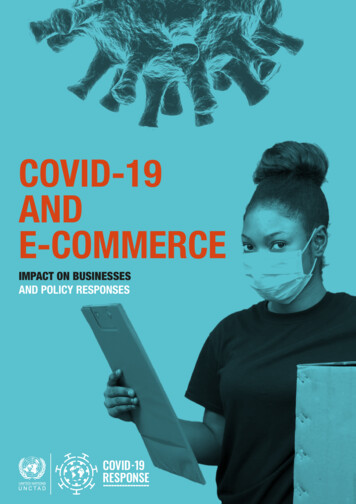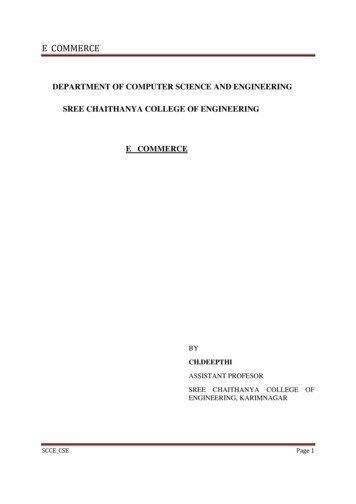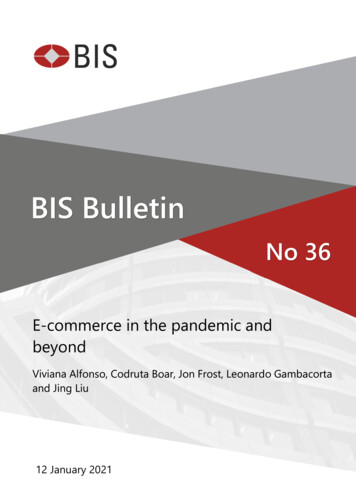
Transcription
COVID-19ANDE-COMMERCEIMPACT ON BUSINESSESAND POLICY RESPONSES
2020, United Nations Conference on Trade and Development.The findings, interpretations and conclusions expressed herein are those of the authors and do notnecessarily reflect the views of the United Nations or its officials or Member States.The designations employed and the presentation of material on any map in this work do not imply theexpression of any opinion whatsoever on the part of the United Nations concerning the legal statusof any country, territory, city or area or of its authorities, or concerning the delimitation of its frontiersor boundaries.This document has not been formally edited.UNCTAD/DTL/STICT/INF/2020/2TABLE OFCONTENTCOVID-19 AND E-COMMERCE IMPACT ON BUSINESSES AND POLICY RESPONSES2
Table of contentsAcknowledgements. 5Introduction. 6Key findings. 6Methodology. 9Profiling respondents. 10Impact on e-commerce businesses. 13Overall sales trends. 13Most used sales channels by e-commerce companies. 14Variations in the composition of sales. 15Payment methods. 16Business outlook: impact on costs and workforce. 17Challenges, business coping strategies and policy responses. 18Main challenges encountered . 18Business facilitation measures: an overview. 20E-commerce business facilitation measures: examples from the public sector. 22Country highlights by policy area. 24Public-private cooperation and private sector initiatives. 29Financing. 31Way forward. 32Measures to support COVID-19 recovery plans through e-commerce development. 32Conclusions: UNCTAD support and eTrade for all partnership. 34TABLE OFCONTENTCOVID-19 AND E-COMMERCE IMPACT ON BUSINESSES AND POLICY RESPONSES3
List of FiguresFigure 1Impact of COVID-19 crisis on monthly e-commerce sales (in per cent). 7Figure 2Top 10 most important measures taken during the COVID-19 crisis (in per cent). 8Figure 3Number of respondents per survey section. 10Figure 4Number of respondents per country of e-commerce operation. 11Figure 5Type of online business (in per cent). 12Figure 6Size of workforce (in per cent). 12Figure 7Impact of COVID-19 crisis on monthly e-commerce sales (in per cent). 13Figure 8Third-party marketplaces: changes in buyers and sellers since the outbreakof the COVID-19 crisis (in per cent). 14Figure 9Main sales channels, before outbreak of COVID-19 and channelswith highest recent growth (in per cent). 14Figure 10 Types of goods and services sold online by e-commerce companiesbefore the COVID-19 outbreak (in per cent). 15Figure 11 Third-party marketplaces: top 5 sales categories before and afterthe COVID-19 crisis (in per cent). 16Figure 12 Payment methods with highest growth since outbreakof the COVID-19 crisis (in per cent). 17Figure 13 Changes in costs and workforce size since the outbreakof the COVID-19 crisis (in per cent). 17Figure 14 Top 5 challenges during COVID-19 (in per cent). 18Figure 15 Challenges since the COVID-19 outbreakin eTrade for all Policy Areas (in per cent). 19Figure 16 Most important measures taken during the COVID-19 crisis (in per cent). 21Figure 17 Number of governmental/public sector measures takenby country to support e-commerce businesses sincethe outbreak of the COVID-19 crisis . 22Figure 18 Number of countries reporting to have taken governmental/publicsector measures to support e-commerce businesses sincethe outbreak of the COVID-19 crisis. 23Figure 19 Company involvement in new public-private sector initiatives to supporte-commerce (in per cent). 30Figure 20 Reasons for not participating in new public-private initiativesor in joint private sector collaboration (in per cent). 30Figure 21 Search for financing since the outbreak of the COVID-19 crisisand purpose of funding (in per cent). 31Figure 22 Source of new financing (in per cent). 31Figure 23 Measures that could support COVID-19 recovery (in per cent). 32Figure 24 Overview of UNCTAD support through eT Readies. 35Figure 25 Overview of UNCTAD support in the development of e-commerce strategies . 35TABLE OFCONTENTCOVID-19 AND E-COMMERCE IMPACT ON BUSINESSES AND POLICY RESPONSES4
AcknowledgementsThis paper was prepared by a team comprising Alessandro Vitale (team lead) and Laura Cyron,in close collaboration with Louis-Pierre Michaud and Vincent Riegel, under the supervision ofCécile Barayre and overall guidance of Torbjörn Fredriksson.The paper is based on a survey that greatly benefited from valuable inputs from a number of surveytesters: Priyanka Chetry (Grocerdel, Cambodia), Ibrahima Diagne (GAINDE2000, Senegal), FrancisDufay and Abdesslam Benzitouni (Jumia, Ivory Coast), Melanie Mossard (Impact Hub Phnom Penh,Cambodia), Jumanne Rajabu Mtambalike (Sahara Ventures, Tanzania), Ounteni Ouoba (RigoFaso,Burkina Faso), Maxime Rosburger (Mealtemple, Cambodia), Mahamadi Rouamba (BeeogoLab,Burkina Faso), Mohamed Sow (Jumia, Senegal), and Sam Saili (MauaApp, Samoa).The UNCTAD team wishes to express its profound gratitude to the eT Ready Focal Points and resourcepersons who responded to the public sector questionnaire and played a proactive role in mobilizingsurvey respondents in their respective countries as: Mostafizur Rahaman Sohel (BASIS E-CommerceAlliance, Bangladesh), Cokou Gagnon (Agence des Services et Systèmes d’Information, Benin),Sonam Chedup (Ministry of Economic Affairs, Bhutan), Seydou Ilboudo and Boubakar Bilgo (Ministryof Industry, Trade and Handicrafts, Burkina Faso), Kemvichet Long and Sven Callebaut (Ministry ofCommerce, Cambodia), Kaladji Fadiga (Ministry of Commerce and Industry, Côte d’Ivoire), DonnaTekanene Reiher and Angoango Fakaua (Ministry of Commerce, Industry and Cooperatives, Kiribati),Lattanaphone Voungsohuti (Ministry of Industry and Commerce, Lao PR), Phera Lepati (Ministry ofTrade and Industry, Lesotho), Gil Razafintsalama (Board of e-trade, Madagascar), Moriba Camara(General Directorate for Trade, Consumer Affairs and Competition, Mali), Su Thet Hninn (Ministryof Commerce, Myanmar), Mahesh Acharya (Joint Secretary, Government of Nepal), Tino Safiatou(Ministry of Commerce and Private Sector Promotion, Niger), Jean Premier Bienvenu Rukundo(Ministry of Trade and Industry, Rwanda), Fiona Lene, Roger Toleafoa and Nella Tavita (Ministryof Foreign Affairs and Trade, and Ministry of Commerce, Industry and Labour, Samoa), BoubacarMbodj, Faramkha Diop, Assane Diankha, and Marième Soda Gueye (Ministry of Trade, Senegal),Aïchétou Touré Ali (Ministry of Trade, Industry, Private Sector Development and Local Consumption,Togo), Khabbab Hadhri (Ministry of Commerce, Tunisia), Moira Simmons-Avafoa and Darryl Ikbal(Ministry of Fisheries and Trade, Tuvalu), Chris Matsiko (Ministry of Trade, Industry and Cooperatives,Uganda), James Tatangis (Ministry of Tourism, Trade, Commerce and Ni-Vanuatu Business, Vanuatu),Nsangwa Ngwira and Gilbert Chisenga (Ministry of Commerce, Trade and Industry, Zambia).Valuable comments on a draft version of the paper were received from David Souter and UNCTADcolleagues.Graphic design and desktop publishing were done by Magali Studer. Funding by the Government ofGermany is gratefully acknowledged.TABLE OFCONTENTCOVID-19 AND E-COMMERCE IMPACT ON BUSINESSES AND POLICY RESPONSES5
IntroductionSince the outbreak of the new coronavirus disease (COVID-19) pandemic, UNCTAD has played acritical role in raising awareness on the opportunities emerging from the crisis through increasingthe uptake of e-commerce and digital solutions. At the same time, UNCTAD has voiced concernsabout the risk of rising digital inequalities, particularly in least developed countries (LDCs).1 The2020 eCommerce Week organised virtually by UNCTAD and partners of the eTrade for all initiativeprovided a unique platform convening a wide range of stakeholders to assess implications of thecrisis and explore in-depth key digital issues in the context of the COVID-19 pandemic.2 As a followup, UNCTAD assessed the impact on e-commerce businesses across developing countries andLDCs to understand the magnitude of the impact, identify key trends and challenges faced bye-commerce businesses, as well public and private policy responses to cope with the crisis.This paper is based on the results of a survey that investigates the impact of COVID-19 one-commerce businesses from early March to end of July 2020. It focuses on 23 countries, mainlyLDCs, in Africa and Asia-Pacific.3 The countries have all benefitted from UNCTAD’s e-commercecapacity building programmes, either through an eTrade Readiness Assessment (eT Ready) or anational e-commerce strategy.257 representatives of e-commerce businesses, out of 699 invited, responded to the survey andshared their experience following the outbreak of the COVID-19 pandemic. Businesses have beendivided into two groups: companies selling at least parts of their goods or services online and thirdparty online marketplaces. The responses from the private sector were complemented by publicsector responses from 12 countries,4 elaborating on measures taken during the COVID-19 crisis tosupport e-commerce as well as to use e-commerce for economic recovery efforts. The key findingsof this paper are presented below.Key findingsThird-party online marketplaces have performed better than e-commerce companies. Ina nutshell, wholly-digital business models have been more resilient to the current crisis.In terms of sales trends, e-commerce companies have predominantly seen declines in sales, whilenearly 60 per cent of third-party marketplaces have seen increases (see Figure 1). Additionally, halfof the surveyed third-party marketplaces onboarded new sellers on their websites. Close to 60 percent of the third-party marketplaces experienced a rise in the number of buyers.1See px?publicationid 27012See the eWeek Summary Report. 2020finalsummaryreportFINALVERSION-4.pdf3The 23 countries covered by the survey on e-commerce businesses are: 1) Africa: Benin, Burkina Faso, Cote d’Ivoire (non-LDC), Madagascar,Mali, Niger, Rwanda, Senegal, Tanzania, Togo, Tunisia (non-LDC), Uganda, Zambia; 2) Asia: Bangladesh, Bhutan, Cambodia, Lao PDR,Myanmar, Nepal; 3) Pacific: Kiribati, Samoa (non-LDC), Tuvalu, Vanuatu.4The 12 countries having responded to the public sector questionnaire include those highlighted above in italic and Lesotho.TABLE OFCONTENTCOVID-19 AND E-COMMERCE IMPACT ON BUSINESSES AND POLICY RESPONSES6
Figure 1.Impact of COVID-19 crisis on monthly e-commerce sales (in per cent)645834297IncreasedE-commerce companies7StableDecreasedThird-party online marketplacesNote: 180 responses for the e-commerce business track, 72 responses for the third-party marketplace track. Based on the questions “Since theoutbreak of the COVID-19 crisis, how have your monthly e-commerce sales been affected?” and “Since the outbreak of the COVID-19 crisis,how have the monthly sales on your third-party marketplace been affected?”. Results are expressed in per cent of the respondents for eachquestion.The pandemic has accentuated the trend towards greater adoption of social media andgrowth in sales through e-commerce websites. Shifts in consumption habits have alsobeen observed, driven by the need for sourcing essential items. Social media and owne-commerce shops are important sales channels for the e-commerce companies. Both channelshave witnessed higher growth since the beginning of the COVID-19 crisis. The COVID-19 crisis hasbeen associated with a change in sales composition for more than 65 per cent of them. Additionally,the survey confirms that more customers have gone online to look for essential products. Groceries,pharmaceuticals, health and hygiene products, restaurant delivery, as well as financial services, arethe sales categories which saw the largest increases in the COVID-19 crisis through third-partyonline marketplaces.E-payments have experienced fast growth, but cash on delivery remains prominent. Shiftsin consumption habits have been accompanied by a faster uptake of cashless payment methods.Nearly 60 per cent of e-commerce companies and 70 per cent of online third-party marketplacesare seeing relatively higher growth rates in mobile money payments, followed by transaction throughe-banking and credit cards. However, as cash on delivery remains prominent in absolute terms,particularly in LDCs, it has continued to grow since the outbreak of the pandemic as consumers haveincreasingly turned to e-commerce.While the pandemic has been an opportunity for many digital-driven business models,business outlook looks challenging for a significant share of e-commerce businesses.The COVID-19 crisis has adversely affected the costs of 66 per cent of the participants in the sample.Some 56 per cent of respondents reported that their workforce has remained stable so far or mighteven increase in the short term. Still, a high share (44 per cent) of respondents have had to downsizetheir business workforce.The pandemic has reinforced pre-existing bottlenecks in the e-commerce ecosystem thatcountries need to address to benefit from e-commerce development by enhancing theire-trade readiness. Disruptions in supply chains and trade logistics, as well as unaffordable InternetTABLE OFCONTENTCOVID-19 AND E-COMMERCE IMPACT ON BUSINESSES AND POLICY RESPONSES7
access are the main challenges encountered by the respondents. Logistics and trade facilitation hadproved challenging for more than 60 per cent of respondents, linked to disrupted supply chains dueto lockdowns, business closures and closed borders. Additionally, more than 50 per cent consideredtheir operations to have been limited by logistical problems arising from restrictions to movement.Half of the respondents referred to high cost of broadband services. Moreover, respondents calledfor improvements in e-commerce policies and strategies in the COVID-19 response. The currentpandemic has reinforced certain pre-existing bottlenecks in e-commerce ecosystems of thesurveyed countries in significant and interconnected policy areas that are key for the developmentof inclusive e-commerce. Challenges in these areas have affected the capacity of respondents toinvest in e-commerce business growth, further exacerbated gaps in information and communicationtechnology (ICT) adoption, and at the same time highlighted challenges related to consumerprotection and fair competition, and a persistent cash on delivery culture.Public and private sectors have implemented a wide range of measures to mitigate theeffects of the pandemic. Governments and the private sector have taken a range of measures torespond to the challenges brought by the pandemic and to mitigate its economic impact (see Figure2). According to survey responses, the most relevant measures taken include developing or updatingof a national e-commerce strategy, which can rather be interpreted as the renewed impetus shown bygovernments to turn e-commerce into a strategic economic sector amidst the pandemic. Followedby increased e-commerce visibility through advertising campaigns, skills training programmes andreduced e-payment transaction costs. Nevertheless, nearly 1 in 4 respondents indicated that nomeasures had been taken in support for the e-commerce sector. Findings from a public sectorquick scan in 12 out of the 23 countries covered by the survey, show that 9 out of 12 countries haveimplemented forms of liquidity support for the sector. Other measures have focused on reducingcosts of Internet and e-payments as well as supporting logistics efforts.Figure 2.Top 10 most important measures taken during the COVID-19 crisis (in per cent)No measures taken24Development of a national e-commerce strategy23More ads for available e-commerce22Skills training programs20Reduced e-payment costs20Financial incentives and liquidity support19Cheaper Internet access18Maintenance of logistics operations18New e-commerce marketplaces for essentialsNew digital health and education solutionsNew logistics services by private operators161413Note: 211 responses. Based on the question “Since the outbreak of the COVID-19 crisis, which governmental or private sector measures, if any,have been most important to facilitate your e-commerce business?” Maximum 5 choices allowed. Results are expressed as a per cent ofrespondents.TABLE OFCONTENTCOVID-19 AND E-COMMERCE IMPACT ON BUSINESSES AND POLICY RESPONSES8
Policy responses and private sector measures have contributed towards businesstransformation processes and enhanced consumers’ readiness to embrace e-commerce.Respondents further reported that the challenges encountered, and measures taken by both thepublic and private sectors, have contributed to lowering the hurdles for businesses and consumersto use e-commerce services, while pushing businesses to seek greater business efficiency and newmarket niches. They also noted that increased Internet access and online financial transactions havefacilitated business operations and minimized business’ losses in some cases.The COVID-19 crisis served as an accelerator for greater public-private cooperation.However, access to financing for e-commerce businesses remains a paramount obstaclefor economic recovery and growth. Moreover, the COVID-19 crisis has spurred action in thee-commerce sector. As much as 40 per cent and more of the respondents’ businesses have beenor are involved in either public-private sector collaboration initiatives or pure private sector ones. Forthose not involved, lack of awareness of the initiatives and limited professional networks were themain reasons. Only 14 per cent of all respondents managed to obtain more funding. While 65 percent of the businesses surveyed had tried to obtain additional financing, only one out of five hadbeen successful.Respondents have highlighted the need for e-commerce enabling measures in COVID-19recovery plans. For the majority of the survey respondents, having a well-defined nationale-commerce strategy was seen as a top priority for the COVID-19 recovery plans. Reduced costsfor Internet and broadband access, as well as for mobile and other electronic payments were theother top measures recommended to be taken to support the economic recovery.International cooperation and a strong multi-stakeholders’ partnership is needed to boostcountries’ efforts for inclusive e-commerce development. UNCTAD is well poised to mobilizethe eTrade for all partnership to support developing countries and LDCs’ COVID-19 recoveryplans. Building on a successful track-record of implementation of recommendations outlined ineTrade Readiness Assessments (eT Readies),5 UNCTAD is working with many partners, includingUnited Nations Resident Coordinators, to ensure that e-commerce is mainstreamed into nationaldevelopment plans and development partners’ development cooperation frameworks.MethodologyThis paper is primarily based on a survey that investigated the different aspects of COVID-19 impacton e-commerce businesses and policy responses. It focused on 23 countries in Africa and the AsiaPacific region which have benefitted from UNCTAD’s e-commerce capacity building programmes(eTrade Readiness Assessments - eT Readies - and national e-commerce strategies). UNCTADbuilt on in-country Focal Points and networks to identify pertinent e-commerce market participantsin June 2020. In addition, the list of e-commerce stakeholders from previous eT Readies was alsoused. The private sector questionnaire, conducted in French and English, targeted two types ofbusinesses i) companies selling at least part of their goods and services online, and ii) third-partyonline marketplaces. Where relevant these two types of businesses responded to separate sets ofquestions, tailored to the specific type of business. The questionnaire was tested early June 2020 bya selected group of representatives of the two target groups, as well as some resource persons fromBurkina Faso, Cambodia, Samoa, Senegal, and Uganda. Based on their feedback, the questionnairewas revised before dissemination started in early July 2020 via SurveyMonkey. In parallel, FocalPoints were asked through a short questionnaire to inform about government measures related toe-commerce for COVID-19 crisis recovery plans. Twelve countries complemented the survey withtheir questionnaire responses.6 The survey was closed in the first week of August 2020.As the number of initial contacts per country varied, so does the number of responses obtained percountry. Hence, results and findings should be interpreted with caution. This analysis is descriptivein nature for the recent experience of e-commerce sector participants, but it is not representative in5UNCTAD (2020), “Fast-tracking implementation of eTrade Readiness Assessments”, forthcoming.6The 23 countries covered by the survey on e-commerce businesses are: 1) Africa: Benin, Burkina Faso, Cote d’Ivoire (non-LDC), Madagascar,Mali, Niger, Rwanda, Senegal, Tanzania, Togo, Tunisia (non-LDC), Uganda, Zambia; 2) Asia: Bangladesh, Bhutan, Cambodia, Lao PDR, Myanmar,Nepal; 3) Pacific : Kiribati, Samoa (non-LDC), Tuvalu, Vanuatu. The 12 countries having responded to the public sector questionnaire include thosehighlighted above in italic and Lesotho.TABLE OFCONTENTCOVID-19 AND E-COMMERCE IMPACT ON BUSINESSES AND POLICY RESPONSES9
terms of market size, in-country and cross-country distribution. Consequently, based on the profileof respondents that follows in the next section, the readers should also be alerted of potential biasesdue to over- or under-representation of countries in terms of number of respondents, as well asvarying regional/continental trade and development patterns, and different development status.Profiling respondentsIn depth responses from 257 respondents representing online businesses. To gatherrespondents, the survey invitation was sent to 699 contacts. In total, 345 individuals responded.The survey was targeted only at those businesses that were involved in e-commerce. Of the 345respondents, 301 met the assessment criteria, i.e. to be part of a business selling, at least in part,online, while 44 were not selling online. For the latter group, the survey ended after this question.Figure 3 presents an overview of the number of survey respondents per stage of the survey. Outof the 301, a further 44 discontinued their responses after the initial screening question despite notbeing filtered out. Therefore, this paper is based on an initial sample of 257 respondents, from 245distinct businesses.7Figure 3.Number of respondents per survey sectionSurvey invites sent: 699Overall participants: 345Screening questionRespondents in e-commerce:301E-commerce companyrespondents: 184Third-party onlinemarketplace respondents: 73Respondents in non-onlinebusiness: 44Survey ends for themNon-response after screeningquestion: 44E-commerce companies and third-party online marketplaces from 23 countries participatedin the survey, mostly from LDCs. In terms of demographics, a quarter of all respondents hadtheir e-commerce operations in Bangladesh. In Rwanda, Senegal, Myanmar, Cote d’Ivoire, Zambia,Samoa, Uganda, Togo, Benin and Nepal more than 10 people responded (see Figure 4). Thesedifferences are due to varying numbers of initial contacts and the sharing of the links among possiblerespondents, which was encouraged. Additionally, the size of each country’s e-commerce marketsvaries significantly, in some cases the market has only a limited number of participants. Two-thirds8of the respondents used the English survey and the remaining third the French one. Furthermore, 61per cent of respondents are male, 38 per cent of respondents are female and the remaining 1 percent expressed a non-binary response.7This might be due to multiple respondents for the same business, i.e. third-party online marketplaces across multiple countries or the samecompany with different business lines.8177 out of 257 respondents used the English survey (68.87 per cent).TABLE OFCONTENTCOVID-19 AND E-COMMERCE IMPACT ON BUSINESSES AND POLICY RESPONSES10
Figure 4.Number of respondents per country of e-commerce e l10Burkina ribati4Kenya3Laos3Mali3Tuvalu3Niger2Tanzania2Note: 257 responses. Based on the question “Please indicate in which country your business operates. If your company/online marketplace operatesin more than one country, please choose one. It should be the one for which you as business representative filling this questionnaire have indepth knowledge and responsibilities of business operations”.72 per cent of respondents represent e-commerce companies and the majority ofbusinesses in the sample are small enterprises with less than 10 employees. More thantwo thirds of respondents are businesses that sell their own goods and services, at least partially,online (see Figure 5). Slightly less than 30 per cent of the respondents represent third-party onlinemarketplaces. The majority of businesses surveyed had less than 10 employees, 30 per cent had10-50 employees the remainder were larger companies (see Figure 6).TABLE OFCONTENTCOVID-19 AND E-COMMERCE IMPACT ON BUSINESSES AND POLICY RESPONSES11
Figure 5.Type of online business (in per cent)Figure 6.Size of workforce (in per cent)1928522972Company that sells goods/services online0-9 employeesThird-party online marketplace10-50 employeesMore than 50 employeesNote: 257 responses. Based on the question “Which option describesyour business best?”Note: 257 responses. Based on the question “Please indicate the sizeof your workforce”.TABLE OFCONTENTCOVID-19 AND E-COMMERCE IMPACT ON BUSINESSES AND POLICY RESPONSES12
Impact on e-commerce businessesOverall sales trendsE-commerce companies have predominantly seen declines in sales, while nearly 60 percent of third-party online marketplaces have seen increases in sales. The latter onboardednew sellers and attracted more customers. For the businesses surveyed, the outbreak of theCOVID-19 crisis has had a split effect (see Figure 7). About 58 per cent of e-commerce companiesselling goods and services online had experienced reductions in sales. The majority of the them hadseen their sales decline by more than 50 per cent, which can be attributed to lockdown measuresor other restrictions including limits to movement of people and transport of goods (see also SectionIII below). However, around 30 per cent of them had observed an increase in their monthly sales.In contrast, for the third-party online marketplaces, nearly 60 per cent had experienced increasedsales. For 37 per cent of the marketplaces, sales had increased by between 10 and 50 per cent. Theincreases in sales experienced by third-party online marketplaces has been accompanied by risingnumbers of buyers
support e-commerce as well as to use e-commerce for economic recovery efforts. The key findings of this paper are presented below. Key findings Third-party online marketplaces have performed better than e-commerce companies. In a nutshell, wholly-digital busine










